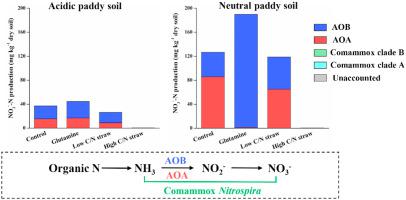Soil Biology and Biochemistry ( IF 9.8 ) Pub Date : 2021-03-02 , DOI: 10.1016/j.soilbio.2021.108192 Haiyang Liu , Hangwei Hu , Xing Huang , Tida Ge , Yongfu Li , Zhenke Zhu , Xingmei Liu , Wenfeng Tan , Zhongjun Jia , Hongjie Di , Jianming Xu , Yong Li

|
Chemoautotrophic canonical ammonia-oxidizers and complete ammonia oxidizers (comammox) are responsible for ammonia oxidation, which is the rate-limiting step of nitrification in terrestrial ecosystems. However, the relative importance of autotrophic nitrification and the related active nitrifiers during mineralization of organic substances with different C/N ratios have not been fully elucidated to date. In this study, 15N tracing and 13CO2-DNA-based stable isotope probing (DNA-SIP) techniques were employed to investigate the responses of soil nitrification processes and the active nitrifying phylotypes in acidic and neutral paddy soils with amendment of glutamine (Gln) or rice straw with low C/N (LS) or high C/N (HS). Acetylene (C2H2) was utilized to differentiate autotrophic and heterotrophic nitrification. The results indicated that C2H2 completely blocked the production of 15NO3− in Gln and LS treatments, implying the predominance of autotrophic nitrification with the N derived from the mineralization of Gln and LS. Neither 15NH4+ nor 15NO3− was detected in the HS-amended soils, suggesting that NH4+ derived from organic N mineralization was immobilized immediately by microorganisms. In the DNA-SIP microcosms, the abundance of ammonia-oxidizing bacteria (AOB) in the unamended control (CK), Gln and LS treatments of acidic paddy soil increased by 22.1-, 71.9- and 27.6-fold, respectively. A significantly larger proportion of Nitrosospira-like AOB, rather than ammonia-oxidizing archaea (AOA) and comammox Nitrospira, was labelled by 13CO2, indicating that AOB made a stronger contribution to autotrophic nitrification in acidic paddy soil. The active nitrification of neutral paddy soil was predominated by AOA affiliated with the Nitrososphaera viennensis lineage in the CK and LS microcosms but by Nitrosospira-like AOB in the Gln microcosm. These results suggest the significance of autotrophic nitrification catalysed by canonical ammonia oxidizers, rather than comammox, during the mineralization of organic substances with low C/N in paddy soils.
中文翻译:

在两种稻田土壤中有机物矿化过程中,典型的氨氧化剂而不是昏迷的硝化螺菌在自养硝化中占主导地位。
化学自养规范氨氧化剂和完全氨氧化剂(comammox)负责氨氧化,这是陆地生态系统中硝化的限速步骤。然而,迄今为止,尚未完全阐明自养硝化和相关活性硝化剂在矿化具有不同C / N比的有机物质过程中的相对重要性。在这项研究中,采用15 N示踪法和13种基于CO 2 -DNA的稳定同位素探测(DNA-SIP)技术研究了谷氨酰胺修饰的酸性和中性稻田土壤硝化过程的响应和活性硝化系统型( Gln)或低C / N(LS)或高C / N(HS)的稻草。乙炔(C 2 H2)用于区分自养硝化和异养硝化。结果表明,c ^ 2 ^ h 2完全阻断生产的15 NO 3 -在Gln,和LS处理,这意味着自养硝化的优势与N从谷氨酰胺和LS的矿化的。既不15 NH 4 +,也不15 NO 3 -中的HS-修正土壤中检测到,这表明NH 4 +源自有机氮矿化的有机物立即被微生物固定。在DNA-SIP微观世界中,未处理的对照(CK),Gln和LS处理的酸性稻田中氨氧化细菌(AOB)的丰度分别增加了22.1,,71.9和27.6倍。的显著比重较大Nitrosospira样AOB,而不是氨氧化古菌(AOA)和comammox硝化螺,被标记的13 CO 2,这表明AOB由在酸性水稻土到自养硝化更强的贡献。在CK和LS微观领域中,中性稻田土壤的主动硝化作用主要由属于亚硝藻谱系的AOA所主导,而对于Gln缩影中的亚硝基螺菌样AOB。这些结果表明,在水稻土中低碳氮比的有机物矿化过程中,由规范性氨氧化剂而不是comammox催化的自养硝化作用具有重要意义。











































 京公网安备 11010802027423号
京公网安备 11010802027423号